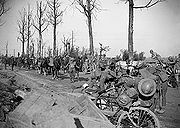
Army Cyclist Corps
Encyclopedia

Corps
A corps is either a large formation, or an administrative grouping of troops within an armed force with a common function such as Artillery or Signals representing an arm of service...
of the British Army
British Army
The British Army is the land warfare branch of Her Majesty's Armed Forces in the United Kingdom. It came into being with the unification of the Kingdom of England and Scotland into the Kingdom of Great Britain in 1707. The new British Army incorporated Regiments that had already existed in England...
active during the First World War, and controlling the Army's bicycle infantry
Bicycle infantry
Bicycle infantry are infantry soldiers who maneuver on battlefields using bicycles. The term dates from the late 19th century, when the "safety bicycle" became popular in Europe, the United States and Australia. Historically, bicycles lessened the need for horses, fuel and vehicle maintenance...
.
Volunteer cyclist units had been formed as early as the 1880s, with the first complete bicycle unit (the 26th Middlesex Rifle Volunteers) being raised in 1888. Cyclists were employed on an intermittent basis during the South African War - whilst they were not deployed as organised combat formations, the bicycle was found to be invaluable for reconnaissance and communications work, being lighter, quieter, and logistically much easier to support than horses. When the Haldane reforms
Haldane Reforms
The Haldane Reforms were a series of far-ranging reforms of the British Army made from 1906 to 1912, and named after the Secretary of State for War, Richard Burdon Haldane...
in 1908 reorganised the volunteers into the Territorial Force
Territorial Force
The Territorial Force was the volunteer reserve component of the British Army from 1908 to 1920, when it became the Territorial Army.-Origins:...
, nine battalions of cyclists were formed - one from the 26th Middlesex, five from volunteer infantry battalions, and three newly raised.
- 25th (County of London) (Cyclist) Battalion, The London Regiment (from the 26th Middlesex)
- 10th (Cyclist) Battalion, The Royal ScotsThe Royal ScotsThe Royal Scots , once known as the Royal Regiment of Foot, was the oldest, and therefore most senior, infantry regiment of the line in the British Army, having been raised in 1633 during the reign of Charles I of Scotland...
- 5th (Cyclist) Battalion, The East Yorkshire Regiment
- 8th (Cyclist) Battalion, The Royal Highland Regiment (The Black Watch); later the Highland Cyclist Battalion
- 6th (Cyclist) Battalion, The Norfolk Regiment
- 7th (Cyclist) Battalion, The Welsh Regiment
- 8th (Cyclist) Battalion, The Northumberland Fusiliers; later the Northern Cyclist Battalion
- 6th (Cyclist) Battalion, The Queen's Own (Royal West Kent Regiment); later the Kent Cyclist Battalion
- The Essex and Suffolk Cyclist Battalion
A tenth, the 7th (Cyclist) Battalion, The Devonshire Regiment
The Devonshire Regiment
The Devonshire Regiment was an infantry regiment of the British Army which served under various titles from 1685 to 1958. Its lineage is continued today by The Rifles.-Origin and titles:...
, was raised later in 1908; in 1910, the Essex and Suffolk Cyclist Battalion split into the 8th (Cyclist) Battalion, The Essex Regiment and the 6th (Cyclist) Battalion, The Suffolk Regiment; in 1911, the 6th (Cyclist) Battalion, The Royal Sussex Regiment and 9th (Cyclist) Battalion, The Hampshire Regiment were formed; and in early 1914, the Huntingdonshire Cyclist Battalion was formed. On the eve of the First World War, the Territorial Force
Territorial Force
The Territorial Force was the volunteer reserve component of the British Army from 1908 to 1920, when it became the Territorial Army.-Origins:...
thus stood at a strength of fourteen cyclist battalions. Ten of these were Territorial battalions of regular infantry regiments, whilst four - the Huntingdonshire, Highland, Northern and Kent Cyclists - were independent battalions without regimental affiliation.
None of the territorial units saw service overseas in the first months of the war, all being used for coastal defence work inside the United Kingdom
United Kingdom
The United Kingdom of Great Britain and Northern IrelandIn the United Kingdom and Dependencies, other languages have been officially recognised as legitimate autochthonous languages under the European Charter for Regional or Minority Languages...
. In 1915, the Army Cyclist Corps was founded to encompass these battalions; it later extended to cover a dozen more battalions raised from second-line yeomanry
Yeomanry
Yeomanry is a designation used by a number of units or sub-units of the British Territorial Army, descended from volunteer cavalry regiments. Today, Yeomanry units may serve in a variety of different military roles.-History:...
regiments which had been converted to cyclists.
Most units of the Corps served out their time in the United Kingdom, providing replacement drafts to infantry battalions; some were converted back to conventional infantry and saw active service, such as the Kent Cyclists (on the North-West Frontier
North-West Frontier (military history)
The North-West Frontier was the most difficult area, from a military point of view, of the former British India in the Indian sub-continent. It remains the frontier of present-day Pakistan, extending from the Pamir Knot in the north to the Koh-i-Malik Siah in the west, and separating the...
) or the 10th Royal Scots (in northern Russia).
Formed units of the Corps were not sent overseas; this was done in small groups of men, with the divisions possessing individual cyclist companies and composite battalions later formed at corps level. These were rarely committed to action, rather being held back in preparation for the resumption of "normal" mobile warfare. On the occasions that cyclists were employed in combat, they were generally found to be ineffective; the terrain on the Western Front was unsuitable for them, causing the bicycles to be discarded early on and the unit proceeding as normal infantry.
Following the war, cyclists were perceived to have little value, and the Corps was disbanded in 1919; by 1922 all remaining Territorial cyclist battalions had been converted back to conventional units.

